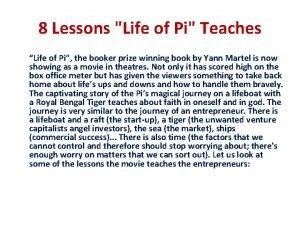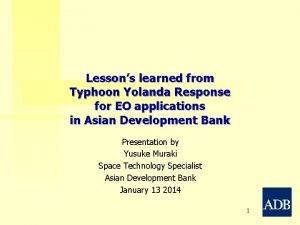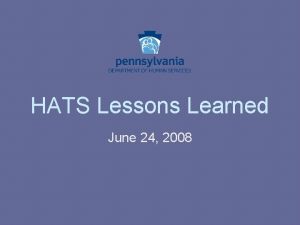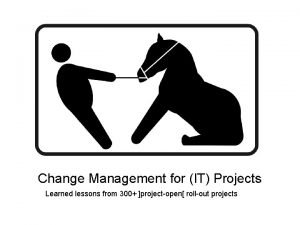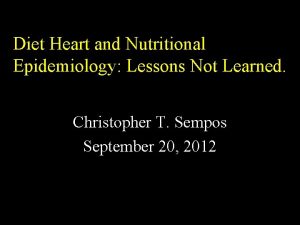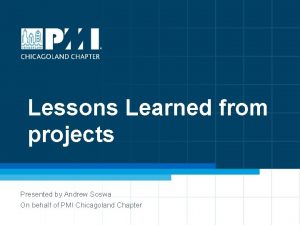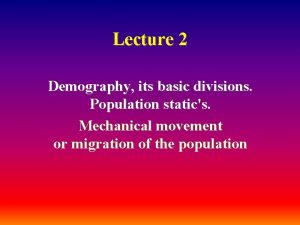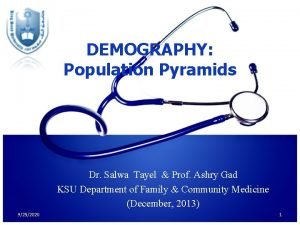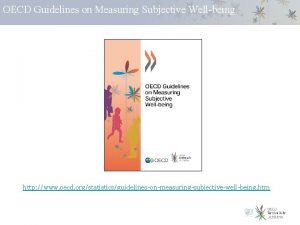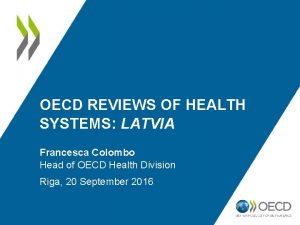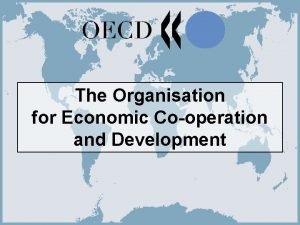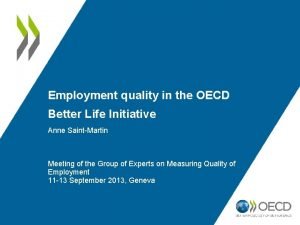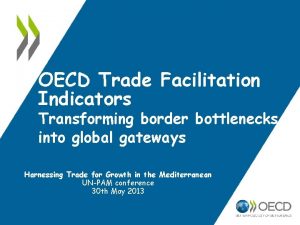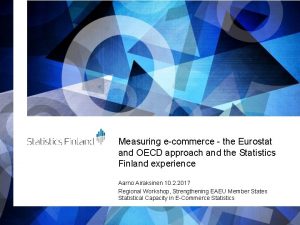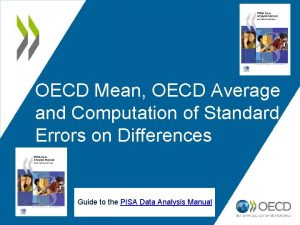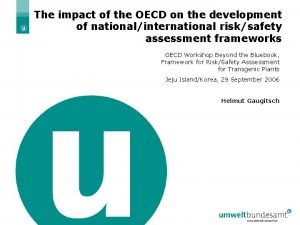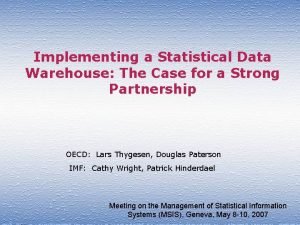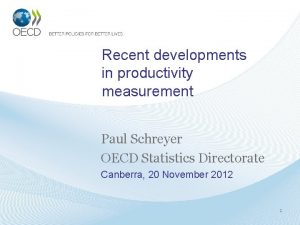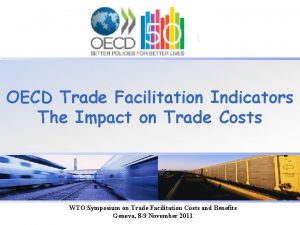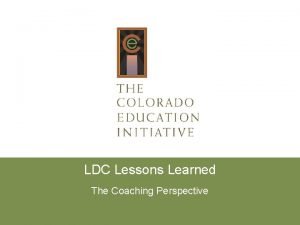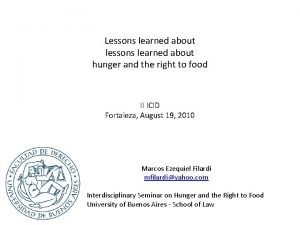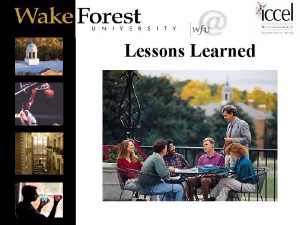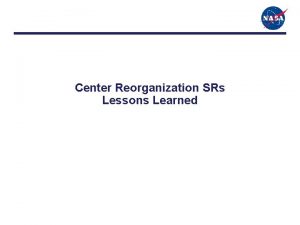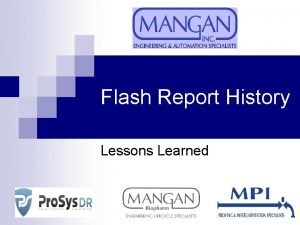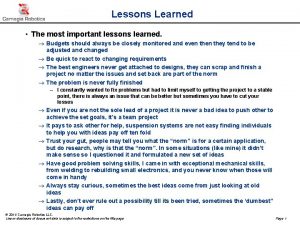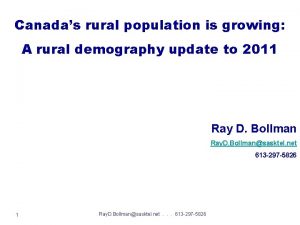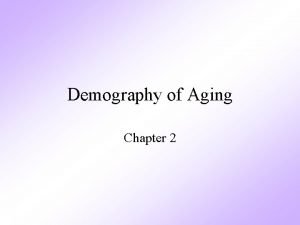OECD Workshop Rural Demography Lessons Learned from OECD





























































- Slides: 61

OECD Workshop Rural Demography: Lessons Learned from OECD Countries October 19, 2010 Challenges of Rural Ageing Population in Japan and Some Responses to Revitalize Rural Community Fumihiro Kabuta, Policy Research Coordinator Policy Research Institute Ministry of Agriculture, Forestry and Fisheries

|Contents I. Introduction: Current situation on Ageing in Japan II. Japanese post-war economic miracle and Demographic Bonus III. Rural Ageing and its Impact on Regional Economics including Agriculture IV. Some Responses to Revitalize Rural Community

I. Introduction: Current Situation on Ageing in Japan Unit: thousand (population) Total Population % Male % Female % 127, 692 100. 0 62, 251 100. 0 65, 441 100. 0 Elderly Population (65 or older) 28, 216 22. 1 12, 044 19. 3 6, 172 24. 7 65 -74 (Early-stage elderly people) 14, 998 11. 7 7, 058 11. 3 7, 939 12. 1 75 or older (Latter-stage elderly people) 13, 218 10. 4 4, 986 8. 0 8, 233 12. 6 Working age population (15 -64) 82, 300 64. 5 41, 405 66. 5 40, 895 62. 5 Child population (0 -14) 17, 176 13. 5 8, 802 14. 1 8, 374 12. 8 Source: Ministry of Internal Affairs and Communications "Population Estimates" (as of October 1, 2008) | 1/5 Male is 65 or older and 1/4 Female is 65 or older. | Only 2. 9 people of working age is supporting 1 elderly.

Transition and Future Projection of Aging

Rapid Change of Population Pyramid 1930 -2055 Year Age Male Female Population (10 thousand) Source: National Institute of Population and Social Security Research

What are Expected to Happen in 2055? | In 2055, 1 out of 2. 5 is 65 or older, and 1 out of four is 75 or older. | Both the population of child and number of births will be half or less that of at present and the working age population will be only 46 million. | Life expectancy for males will be 83. 7 and for females 90. 3. | A society will arrive where 1. 3 people of working age will be supporting 1 elderly. Pension Crisis?

The Rapid and Unique Ageing Process in Japan | Compared with the ageing process of other developed countries, the Japanese ageing level had been relatively low until the early 1990 s. | But the speed of ageing has since been the worlds fastest. | Current Japan’s ageing level will be the highest in the world.

|Contents I. Introduction: Current situation on Ageing in Japan II. Japanese post-war economic miracle and Demographic Bonus III. Rural Ageing and its Impact on Regional Economics including Agriculture IV. Some Responses to Revitalize Rural Community

II. Japanese Post-war Economic Miracle and Demographic Bonus Real GDP Growth Rates in Japan Av. 9. 1%, 1956 -73 Av. 4. 2%, 1974 -90 Av. 0. 8%, 1991 -2009 Source: Cabinet Office, SNA site

Demographic Bonus and Demographic Onus Demographic Bonus Demographic Onus Projection Dependent Population Index Child Population Index Aged Population Index Source: Takao Komine

Demographic Bonus and Economic Development Contribution to Growth Early Demographic Bonus Labor Intensive Industry ex) Textile, Agroindustry Latter Demographic Bonus After Demographic Bonus Capital Intensive Industry Knowledge Intensive Industry ex) Heavy Chemical, Automobile ex) IT, Service Labor Input Domestic Saving Technology Total Factor Productivity Income Increase Population Ageing

Ageing population with lower birthrate and Economic Development Lower Birthrate Smaller Labor Force Lower Domestic Saving Population Ageing More Medical Expenses Heavier Pension Burden Lower GDP Growth Pressure on Both National & Family Budget

When Demographic Bonus Period Ends? Germany France Japan Italy USA 1985 1990 2010 Canada UK Russia China Brazil 2010 2020

|Contents I. Introduction: Current situation on Ageing in Japan II. Japanese post-war economic miracle and Demographic Bonus III. Rural Ageing and its Impact on Regional Economics including Agriculture IV. Some Responses to Revitalize Rural Community

III. Rural Ageing and its Impact on Regional Economics including Agriculture | Urbanization of rural communities (1970) | Emerging negative impacts of rural ageing on agriculture (since 1980) | End of high economic growth widening the GDP gap between urban areas and rural areas (around 1990)

Why Policy on Rural Areas was Needed? -Urbanization of Rural Communities- | In the past, agricultural policy covers all the issues of rural areas, since most of rural community members were farmers. | In 1970, the ratio of farmers in rural communities was first less than half (46%). | Then Gov. started to discuss rural society problems in its white paper in 1971. | Consensus building of communities (ex: pestiside use) | Conflicts on land use (city planning vs rural planning, especially of plain rural areas)

Ageing NOT become big issue in 1970 s | Already rural ageing gradually started. | However, thanks to demographic bonus periods and agricultural labor productivity increase, outflow of young labor force from rural to urban was not a problem. | In 1960 -70 s, national development plan focused on balanced regional developments. Public infrastructure investment Relocating and newly developing industrial zones

15. 3 million people moved into three Metropolitan areas during 1960 -75 10 thousand Tokyo metropolitan area Nagoya metropolitan area Osaka metropolitan area Regional areas

Previous National Development Plans Comprehensive National Development Plan New Comprehensive National Development Plan Third Comprehensive National Development Plan Fourth Comprehensive National Development Plan Grand Design for the 21 st Century Approved by the Cabinet October 5, 1962 May 30, 1969 November 4, 1977 June 30, 1987 March 31, 1998 Administration Ikeda administration Sato administration Fukuda administration Nakasone administration Hashimoto administration Target year 1970 1985 Approx. 10 years from 1977 Approx. 2000 2010 -2015 Basic objective Development designed to maintain regional balance Creation of affluent environments Development of a comprehensive living environment Creation of a multipolar nation Creation of the foundation for a multiaxial nation Development design Design for the development of strategic footholds Design for largescale projects Design for permanent residence Design for communication networks Participation and collaboration Seeking Balanced National Development by preventing too much concentration in Three Metropolitan Areas

Rural Ageing Started to have Negative Impacts on Agriculture and Local Economics in 1980 s | In 1986, the Gov. first discussed the rural ageing especially of hilly and mountainous areas in its policy paper, although rural ageing had already gradually started. | Main issues are: i. Decrease of and some ageing agricultural labor force; ii. Stagnation of agricultural economies; and iii. Growing amount of abandoned cultivated land. Still issues for agricultural policy

Decrease of and ageing agricultural labor force

89 88 87 86 85 80 75 70 90 19 91 19 92 19 93 19 94 19 95 19 96 19 97 19 98 19 99 20 00 20 01 20 02 20 03 20 04 20 05 20 06 19 19 19 Declining Trend of Agriculture GDP in Japan 5. 0 Agriculture GDP Share 4. 5 4. 0 3. 5 3. 0 2. 5 2. 0 1. 5 1. 0 0. 5 0. 0

Growing Amount of Abandoned Cultivated Land Changes in abandoned cultivated land areas (stock) Current uses of Japan’s national territory (10, 000 ha) 45 Industrial land area in residential land area 160, 000 ha (0. 4%) Residential land 1. 83 million ha 5% 40 Cultivated land area 耕地面積 557 546 35 Other 6. 03 million ha 16% National land area 37. 79 million ha 15 10 5 520 24. 4 21. 7 20 504 500 483 13. 1 12. 3 13. 5 560 540 524 30 Forest 25. 12 million ha 66% 38. 6 34. 3 538 25 Agricultural land 4. 81 million ha 13% 580 Abandoned 耕作放棄地 cultivated land 480 469 460 440 References: MLIT, “Annual Report on Land Trends during Fiscal Year 2006” MAFF, Operational materials of the Forestry Agency 0 420 1975 1980 1985 1990 1995 2000 2005 Notes: Agricultural land area is the total area of agricultural lands, grasslands, and pasturelands. 昭和50 昭和55 昭和60 平2 平7 平12 平17 Some sum totals in the breakdown may not match due to rounding off. MAFF, “Census of Agriculture and Forestry, ” “Statistics on Cultivated Land Planted Area”

Ageing and Decreasing Farmers, but NOT Problem Technological improvement Rapid decrease of working hours for farming Excess number of farmers Despite policy interventions, farm size did not increase as planned with a view to balancing the incomes between agriculture and other industry

End of High Economic Growth Widening the GDP Gap Between Urban and Rural Areas | End of economic boom and demographic bonus periods has widened the GDP gap and made difficult structural adjustment. (ex. Decrease of public investment, relocation of factories to abroad) | Needs for new national development scenario. | “Marginal Community” –Depopulated Community of which half population is 65 and older| Not only agriculture but also other local industries in rural areas have been affected by long stagnation and globalization.

Trend of Regional Income Disparities in Japan (Gini coefficient) Wider Regional Disparity Narrower (Fiscal Year) Notes: 1)Calculated based on Prefectural Accounts, Cabinet Office, Government of Japan, as well as Population Census, and Annual Report on Current Population Estimates, Ministry of Internal Affairs and Communications. 2) The income figures of the prefectural residents are calculated based on the 68 SNA for the years before 1989, and 93 SNA thereafter. Source: MLIT

Reform of National Development Plan -Towards Self-supporting Regional Economics Comprehensive National Development Plans National Spatial Strategies National Plan Regional Plans Comprehensive Development Plan of Hokkaido Tohoku Region Hokuriku Region Chugoku Region National Capital Region Chubu Region Kinki Region Kyushu Region Shikoku Region Okinawa Promotion and Development Plan

New National Spatial Planning System Formulation of visions with collaboration between national and local governments Standards for the national land national life defined by the national government (Clarification of the obligations of the national government National and local governments perform their respective functions and work in mutual collaboration and cooperation to formulate plans for each regional block. To facilitate the formulation and implementation of the plans, local branches of national government agencies, prefectures and ordinance-designated cities concerned, and local economic groups organize councils (widearea regional planning councils) to discuss issues on equal terms. National plans only formulated by the national government No opportunities to consult with local governments Participation of a wide range of groups in the formulation of plans Qualitative improvement of the national land, including landscapes and the environment Plans for an aging society + Wide-area regional plans Expansion and revision of plans and schedules Focused on development for quantitative expansion National Spatial Strategies Comprehensive National Development Plans National Plan Conversion from plans focused on development Use of stocks Use and conservation of limited resources Use of the ocean and international cooperation Ensuring safety, security, and stability in daily life, in addition to improving convenience Development of national land for the autonomous development of local communities

Disappearing Agriculture Communities Number of Ag Communities

Decrease in the Number of Municipalities through Merger 3, 232 3500 3000 568 2500 1, 821 1, 793 2000 1500 198 195 846 815 670 777 783 1999 2006 2008 1994 villages towns cities 1000 500 0 Source: Ministry of Internal Affairs and Communications 30

Rapid Ageing Agriculture Labor Force Recently Who will Succeed Japanese Agriculture? No. of Ag Labor Force Av. Age 2005 2. 24 million 64. 2 2000 2. 40 million 62. 2 1995 2. 56 million 59. 6 1990 2. 92 million N. A.

|Contents I. Introduction: Current situation on Ageing in Japan II. Japanese post-war economic miracle and Demographic Bonus III. Rural Ageing and its Impact on Regional Economics including Agriculture IV. Some Responses to Revitalize Rural Community

IV. Some Responses to Revitalize Rural Community | Niche Community Business -Irodori- Village level response - | One Village, One Product Movement - Prefecture level response – | Application of Cluster Regional Development Approach - National & Regional level response - | Application of Compact City Concept Smart Shrinking-

Shift of World Development Paradigm has been shifting from development optimism focusing on big push and trickle-down, through market-led growth, to sustainable development (SD) and poverty reduction. Developing countries now have a tough challenge: achieving balanced, sustainable and accelerated growth at once. To tackle this, some policy makers have begun applying new regional development strategies that focus on location specific dynamism and synergies by participation of heterogeneous group of people. 1950 s and 60 s 1970 s Internatnl. community Investments in modern sector Trickle down Growth + Basic H need National Govt. Development plan Nationalizn. Import substitution Industrialization Agri. policy Rural developmt 1980 s 1990 s 2000 s Market-led Growth SAL Sustainable developmt Poverty reduc. SD Education Infrastruc. Export oriented growth Macro econ. Stability, Balanced growth Balanced Growth, Social Stability, Environment Tax on agriculture Food self sufficiency Diversification Policy reform Value addition (R&D, Irrigation) Irrigation, R&D, agri. extension Integrated rural developmt Community developmt Township enterprises OVOP(OTOP) Rural industrializn. Source: Prof. Kunio Tsubota

Niche Community Business -IRODORI Rural community empowerment through exploring local resources| Kamikatsu Town is located deep in the mountains of Tokushima Prefecture, about 40 km from Tokushima City, capital city of the prefecture. | The town population of 6, 200 in 1955 has dropped over 50 years to only 2, 100. Half of the population became elderly people. | However, thousands of visitors, not only from other parts of Japan but also from abroad, come to this tiny rural town every year. | While Kamikatsu has the highest rate of aged population in Tokushima Prefecture, the elderly people are healthy and lively here. Why?

Tree Leaves for Cuisine Decoration, Especially in High-class Restaurants

Welfare Industry for Elderly


Mind-set Change of People on Local Resources | In the past, Kamikatsu Town People always said “we don’t have anything. ” | And people used to hate persimmon leaves. Because they need to sweep and clean the fallen leaves every day. Leaves used to be a nuisance. But now, those leaves became local treasures. | Leaves have not changed. People have changed their eyes through IRODORI. | People look at the same leaves with new eyes.

Not Think What You Don’t Have | Imagination with community member’s good collaboration could turn “trash” into treasures. Yes, even normal elderly people can do it! | “Imagination is more important than knowledge. ” by Albert Einstein

Origin of One Village One Product (OVOP) | OVOP Movement was advocated by Dr. Hiramatsu in 1979, when he was elected as Governor of Oita prefecture. | The movement was promoted through actual activities with a slogan, “Let’s work together on what we can do in the present condition. ” Ø to prevent depopulation and loss of energy in Oita Prefecture Ø to find and nurture products/industries that could best reflect and benefit each region Ø to eradicate heavy dependency upon government, and to promote autonomy and willingness amongst regional people | However, original OVOP was initiated by farmers’ group in Oyama, a small and mountainous town in Oita Prefecture in 1960’s. Oyama Town – Oita Prefecture – Japan - Asia

NPC Movement in Oyama Town –Origin of OVOPOyama (3, 870 villagers) gave up rice production and focused on plum and chestnut. “Let’s plant plum and chestnut, and go to Hawaii !!!” Highest percentage of passport carrying residents in Japan (70% of the population) Farmers’ group established a strong agriculture cooperative. Oyama changed their products: Plum, chestnut – Dried mushroom (Shiitake) – Enoki mushroom Oyama Agricultural Cooperative Konohana Garuten

Konohana Garten: Shop by Oyama Ag Coop Established in 1990 Annual Sales: JPY 1. 5 billion Number of Customers: 1. 9 million 7 Shops in Oita and Fukuoka Still very successful non-profit agricultural cooperative. Farmer’s homemade dishes 43 Direct sales shop

Three Principles of OVOP Movement in Oita Three principles are: 1) Local yet global ü Creating globally accepted products that reflect pride in the local culture 2) Self-reliance and Creativity ü Realization of OVOP though independent actions utilizing the potential of the region 3) Human Resource Development ü Fostering of people with a challenging and creative spirit

How OVOP was Promoted in Oita? 1. Gov. Hiramatsu proposed the movement to regional leaders 2. Also he conducted series of discussion with farmers and community people 3. PR and Marketing of OVOP product by Governor himself, then the movement was further publicized through mass media 4. Technical support was offered by prefectural research and training institutes, but little direct financial support 5. A special system for marketing OVOP products such as exhibition was set up 6. OVOP award system was introduced for encouragement

Example of Oita OVOP 1. Kabosu lime, Bungo beef, Seki Mackerel…Agriculture product 2. Distilled Spirits (Shochu), Dried Fish……Processed food 3. Bamboo ware, Onta Pottery……………. . . Handicrafts 4. Farmhouse, water mill, log house………. . Building 5. Village of Jinya, Nioza Street……………Historical spot 6. Stone bridge, waterfall…………………. . . Scenery 7. Kuju Highland, hot spring………………. . Natural resource 8. Fox dance, Tsurusaki dance……………. . . Traditional event 9. Music and cinema festival………………. Cultural event 10. Green/agro tourism, village…. . …………Rural-urban interaction OVOP can be developed from anything unique from the local region.

Case 1: Kabosu Limes Output: 4, 550 t (Sales: JPY 1, 014 Billion) Production Market Share: Almost 100% Processed Products made from Kabosu

48

Case 2: Ajimu Town Green Tourism Population: 8, 548 Tourists: 1. 63 million/year Ajimu Green Tourism Study Group 420 members (200 nonresidents) Village Stay, Working Holiday in Agriculture Village

Expansion of OVOP Movement One Village One Treasure (China) One Tambong One Product (Thailand) One Region One Vision (The Phillippines) One Village One Product Day (Los Angeles, USA) Key success factor for OVOP is to identify unused local resources, and improve and market them in a creative way. Motivating Local Pride & HRD

Various Types of OVOP-type Development Models

More Systematic Approach Supported by the National and/or Prefectural Government | How to inspire local ‘Creativity’? Should focus on the unique strengths of specific area, rather than concentrating on ameliorating generic weakness! Each community should bear responsibility for its future success, not the government. Cluster approach, or networking of various stakeholders (= agriculture-commerce-industry collaboration) are a potential tool for mobilizing the local competitiveness.

Application of Porter’s Cluster Approach for Regional Development

Cluster Approach Initiatives in Japan | The previous style of policies carried out uniformly throughout Japan, under centralized management is transformed, and policies are implemented principally by those working in the fields. The Industrial Cluster Program (METI) The Knowledge Cluster Initiative (MEXT) The Agri-Food Industry Cluster (MAFF)

OVOP vs Cluster Approach l. Village community oriented l. Gathering of an industry field l. Each village targets an unique product. l. Both vertical and horizontal linkage l. Collaboration of farmers in a village l. Synergies and dynamism. lbut weak vertical/horizontal linkages among villages l. Advantages of agglomeration Participation Local initiative v. integration May evolve over time Source: Prof. Kunio Tsubota

Agriculture-Commerce-Industry Collaboration or “Sixth Sector Industrialization” | Agriculture-commerce-industry collaboration is a type of cluster approach. | MAFF: Makes Japan’s agriculture stronger → Increase in food self-sufficiency rate (40%) | METI: Stimulates Japan’s regions and enterprises | Domestic production from agriculture/fisheries and food: 103 trillion yen 11% of all industrial production (975 trillion yen) | “Sixth Sector Industrialization” is a coined word for primary + secondary + service sector of industry.

Flow of support under the Law concerning the Promotion of Collaboration among Agriculture, Commerce and Industry 1) Support for businesses “Hands-on support office” Support frameworks are established in 10 regional blocks to provide fine-tuned support by experts “Bases for regional power”—which include commerce and industry associations, chambers of commerce and industry, JA prefectural chuokai, and prefectural support centers for small- and medium-size enterprises (SMEs)—in roughly 316 locations around Japan provide management consultation and dispatch experts. SMEs and businesses involved in agriculture, forestry, or fishery that have partnered to develop a new business Preparation a business plan Approval from an agricultural administration office; bureau of economy, trade and industry; etc. “Food industry cluster” Equipment Installation Support for Small Enterprises, Agricultural Improvement Fund, etc. (zero-interest funding) Sample product development/ placement in exhibitions, etc. At regional “food industry clusters” in 49 locations throughout Japan, venues are set up to help SMEs (such as local food manufacturers) and businesses involved in agriculture, forestry, or fishery get together to plan partnerships, and support is offered for the development of new products using regional agricultural, forestry, and fishery products and expansion of product outlets. Debt guarantee Management improvement “Base for regional power” Capital investment/development of production, sales, and demand Tax reduction for capital investment Low-interest financing *Examples of various budgetary measures that are matched to business-development stages Use of competitive funds to support practical technical development through agriculture-commerceindustry collaboration that is intended to expand agriculture, forestry, fishery, or food industries. Support for increased management efficiency of businesses in agriculture, forestry, or fishery using the know-how of other industries, such as the building of production styles that utilize information technology. 2) Support for supporting organizations NPO or public-interest corporation that supports agriculture-commerceindustry collaboration by providing guidance and advice Preparation of a business plan Approval from an agricultural administration office; bureau of economy, trade and industry; etc. Support for development of sample products and their exhibition; support provided at specific stages in the business-development process, such as reinforcement of efforts to build a quality control system or building of a productionprocessing network. Support for development of product outlets, such as use of vacant shops, launching of websites for specialty product sales, marketing advice provided by former employees of major firms, promotion of exports, etc. Eligibility for credit guarantee Guidance, advice, holding of seminars, etc. Note: Items marked by Support for agriculturecommerce. Industry collaboration indicate support based on legal authorization

Application of Eco-Compact City Concept to Rural Planning Under the circumstances of the progressing decrease in population and aging of society, in order to respond to the requirements of more efficient urban management and actions against global environmental issues, city and life functions are concentrated to selected core sites in each city to secure accessibility to cities via mainly public transportation services, actions for building an Eco-Compact City will be initiated where environment and city functions are concentrated and coexist. By forming the Eco-Compact City, a sustainable city in terms of social, economic and environmental aspects will be built. Image of an Eco-Compact City Core site City parks nearby A site concentrating urban functions that supports people’s daily life Railroad Station Living in cities A site concentrating advanced city functions Concentration of facilities necessary for enhancing convenience of daily life Core site Public transportation services Revitalization of central city area

Empirical Data Supporting Eco-Compact City Ø Urban density emerges as a crucial element to reduce carbon emissions (Source: OECD Report on Competitive Cities and Climate Change (2009)) Urban Density and Electricity Consumption Urban Density and Carbon Emissions in Transport

Smart Shrinking Rural Planning | Some researchers’ group has just started discussing smart shrinking rural planning, although it was taboo to mention ‘shrinking’ in parallel with promoting revitalization of rural areas.

| Thank you very much for your kind attention! | Shoud you have any questions, please do contact me! Fumihiro KABUTA Policy Research Coordinator Policy Research Institute (PRIMAFF) 3 -1 -1, Kasumigaseki, Chiyoda-ku, Tokyo, 100 -0013, Japan TEL: +81 -3 -6737 -9076 FAX: +81 -3 -6737 -9098 E-mail: fkabuta@affrc. go. jp
 Strawman process
Strawman process Lessons learned suomeksi
Lessons learned suomeksi Lessons learned faa
Lessons learned faa Lessons from elijah
Lessons from elijah Life of pi life lessons
Life of pi life lessons Six sigma lessons learned
Six sigma lessons learned The mount carmel contest
The mount carmel contest Typhoon yolanda lessons learned
Typhoon yolanda lessons learned Hyatt regency bridge collapse
Hyatt regency bridge collapse Lessons learned from king josiah
Lessons learned from king josiah Tac lessons learned
Tac lessons learned Nerc lessons learned
Nerc lessons learned Lessons learned from the tower of babel
Lessons learned from the tower of babel Lessons learned ground rules
Lessons learned ground rules Change management lessons learned
Change management lessons learned 2 chronicles 34:1-3
2 chronicles 34:1-3 Dps project title
Dps project title Lessons learned repository
Lessons learned repository Lessons not learned in blood
Lessons not learned in blood The qualities of the ant that i have learned are
The qualities of the ant that i have learned are Claremont workday
Claremont workday Pmbok lessons learned
Pmbok lessons learned Slash and burn agriculture synonym
Slash and burn agriculture synonym Static demography
Static demography Demographic data definition
Demographic data definition Cso business demography
Cso business demography Sources of demography ppt
Sources of demography ppt Elements of demography
Elements of demography Components of demography
Components of demography Exclave ap human geography definition
Exclave ap human geography definition Oecd guidelines on measuring subjective well-being
Oecd guidelines on measuring subjective well-being Guidance on transfer pricing aspects of intangibles
Guidance on transfer pricing aspects of intangibles William hynes oecd
William hynes oecd Oecd modellegyezmény magyarul
Oecd modellegyezmény magyarul Asta auerbach
Asta auerbach Oecd economic outlook
Oecd economic outlook Oecd principles of corporate governance
Oecd principles of corporate governance Francesca colombo drive in
Francesca colombo drive in Civil service skills
Civil service skills Principles of glp
Principles of glp Oecd meaning
Oecd meaning Oecd better life initiative
Oecd better life initiative Oecd trade facilitation indicators
Oecd trade facilitation indicators Eurostat e-commerce
Eurostat e-commerce Oecd scenarios for the future of schooling
Oecd scenarios for the future of schooling Oecd working group on bribery
Oecd working group on bribery Oecd
Oecd Oecd corporate governance definition
Oecd corporate governance definition Oecd gps
Oecd gps Thammassat
Thammassat Oecd nations meaning
Oecd nations meaning Oecd meaning
Oecd meaning Oecd stands for
Oecd stands for Oecd corporate governance principles
Oecd corporate governance principles Oecd data warehouse
Oecd data warehouse Paul schreyer oecd
Paul schreyer oecd Oecd 207
Oecd 207 Oecd trade
Oecd trade Peter green oecd
Peter green oecd Oecd space forum
Oecd space forum William hynes oecd
William hynes oecd Oecd
Oecd




